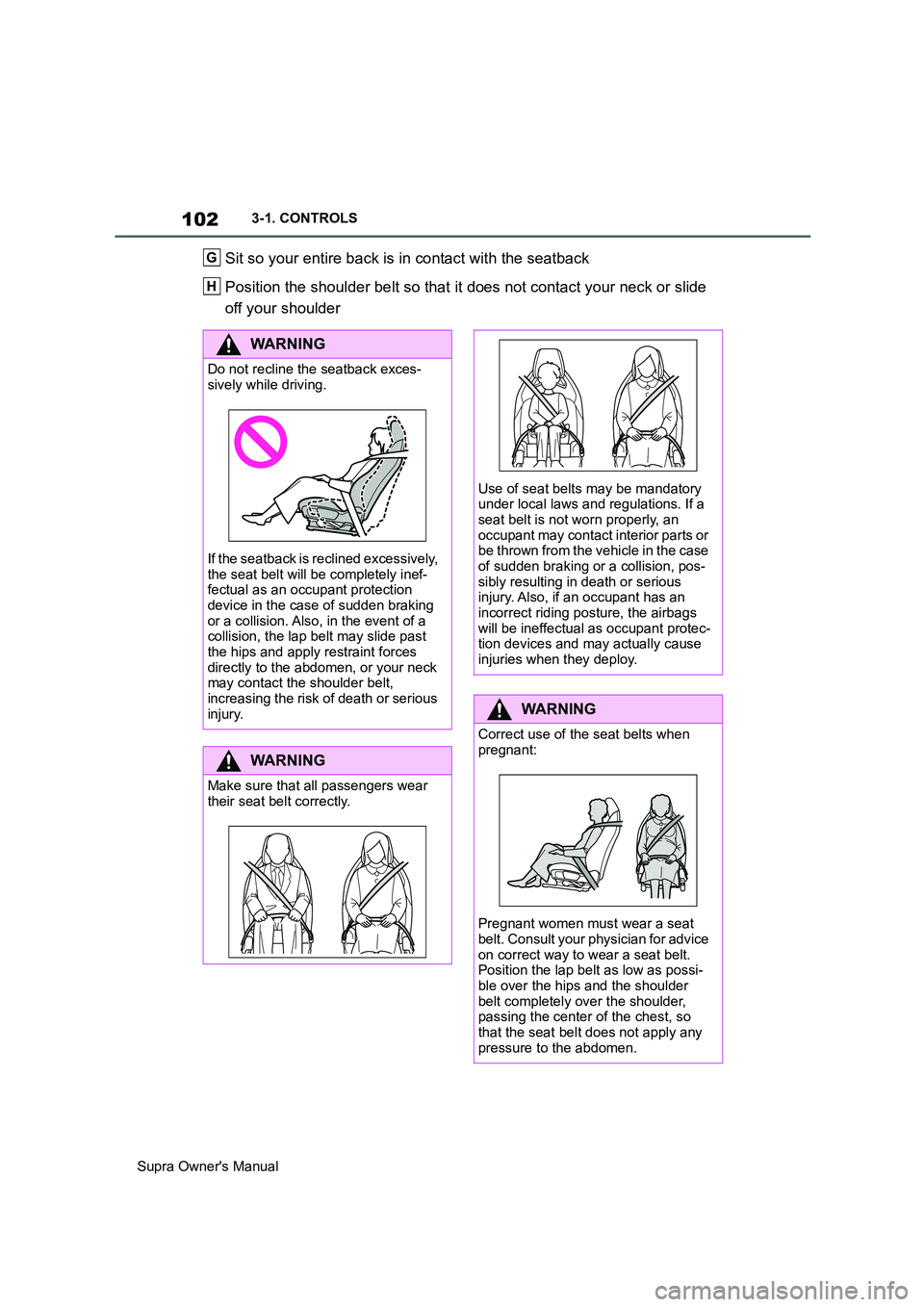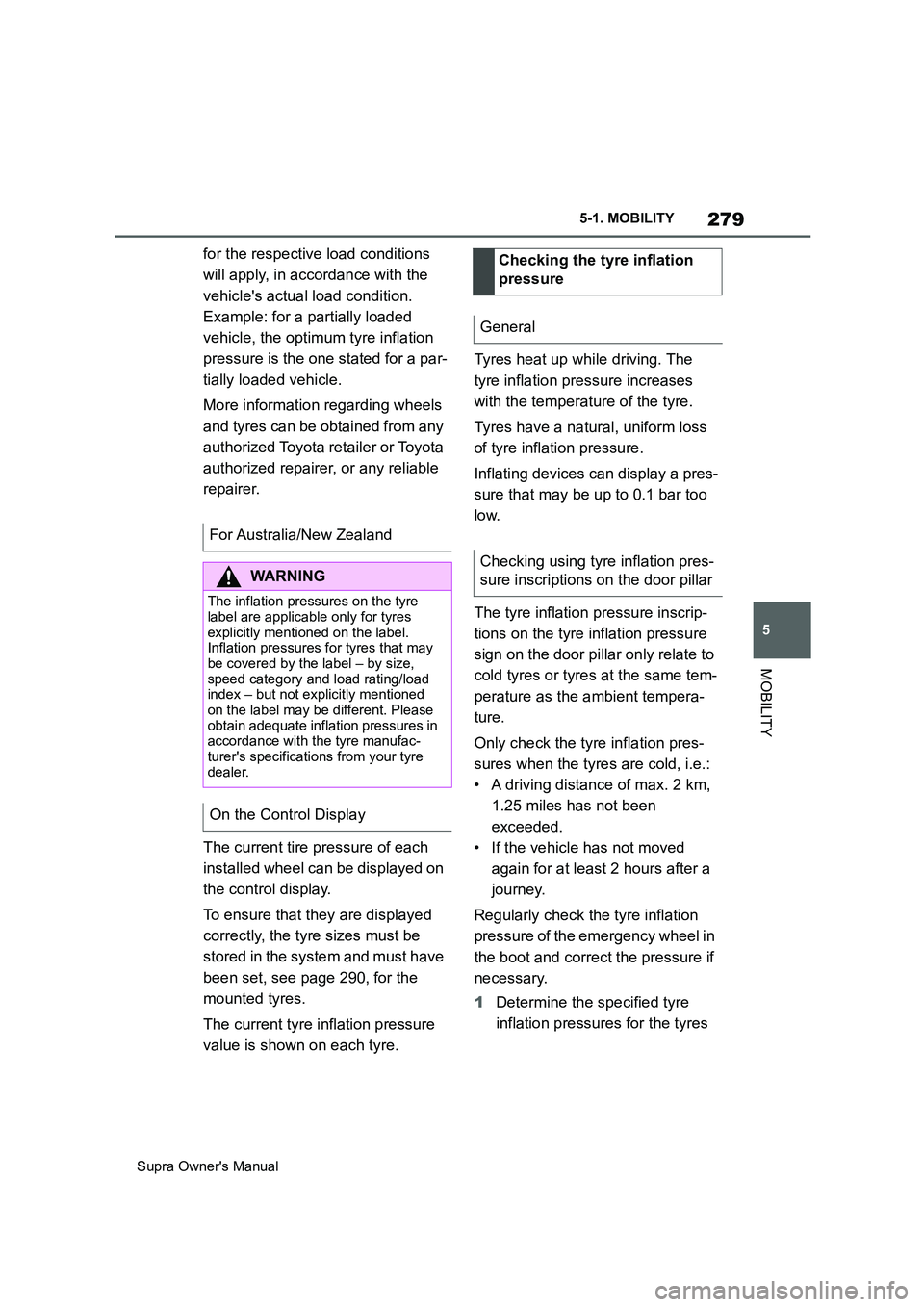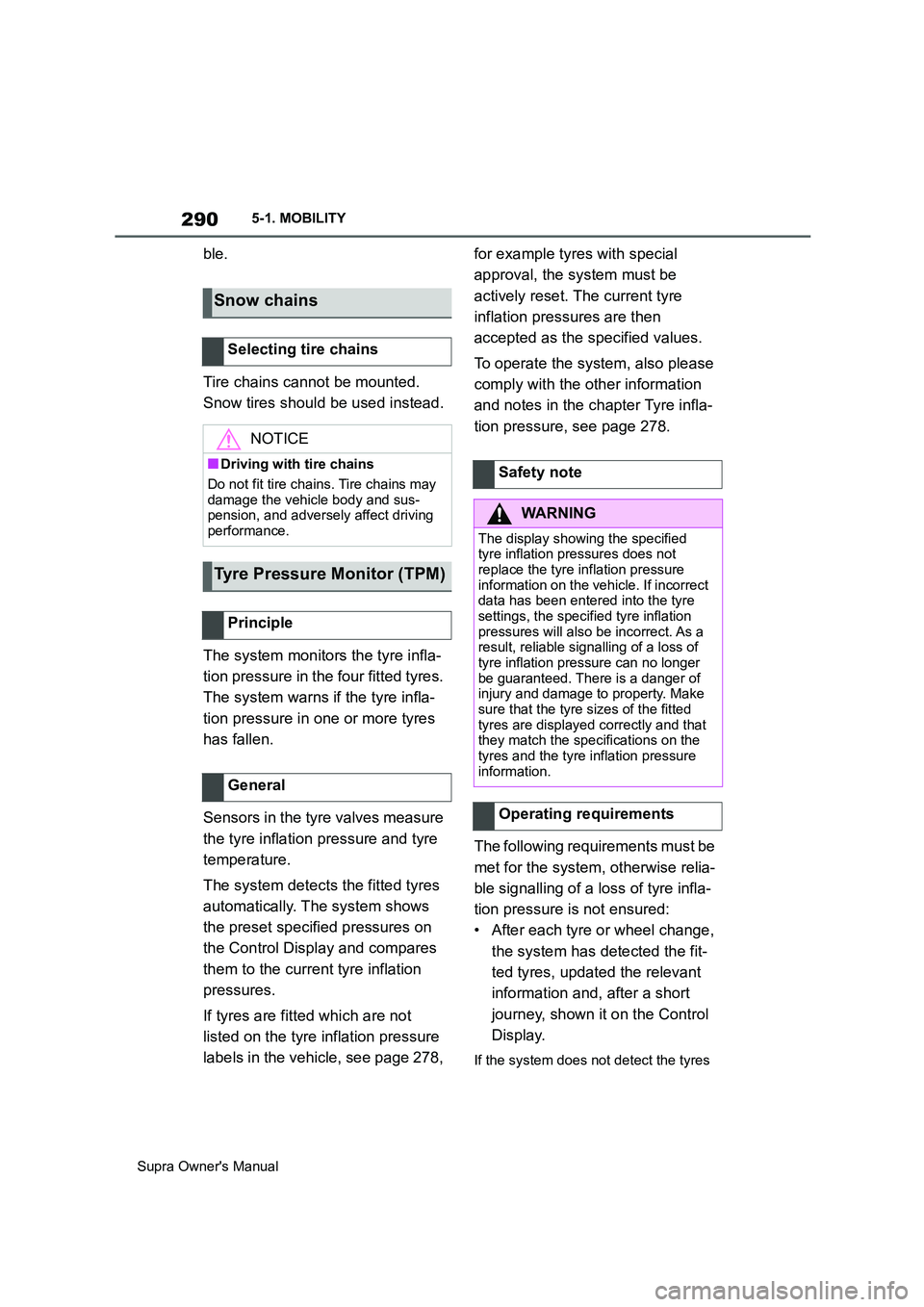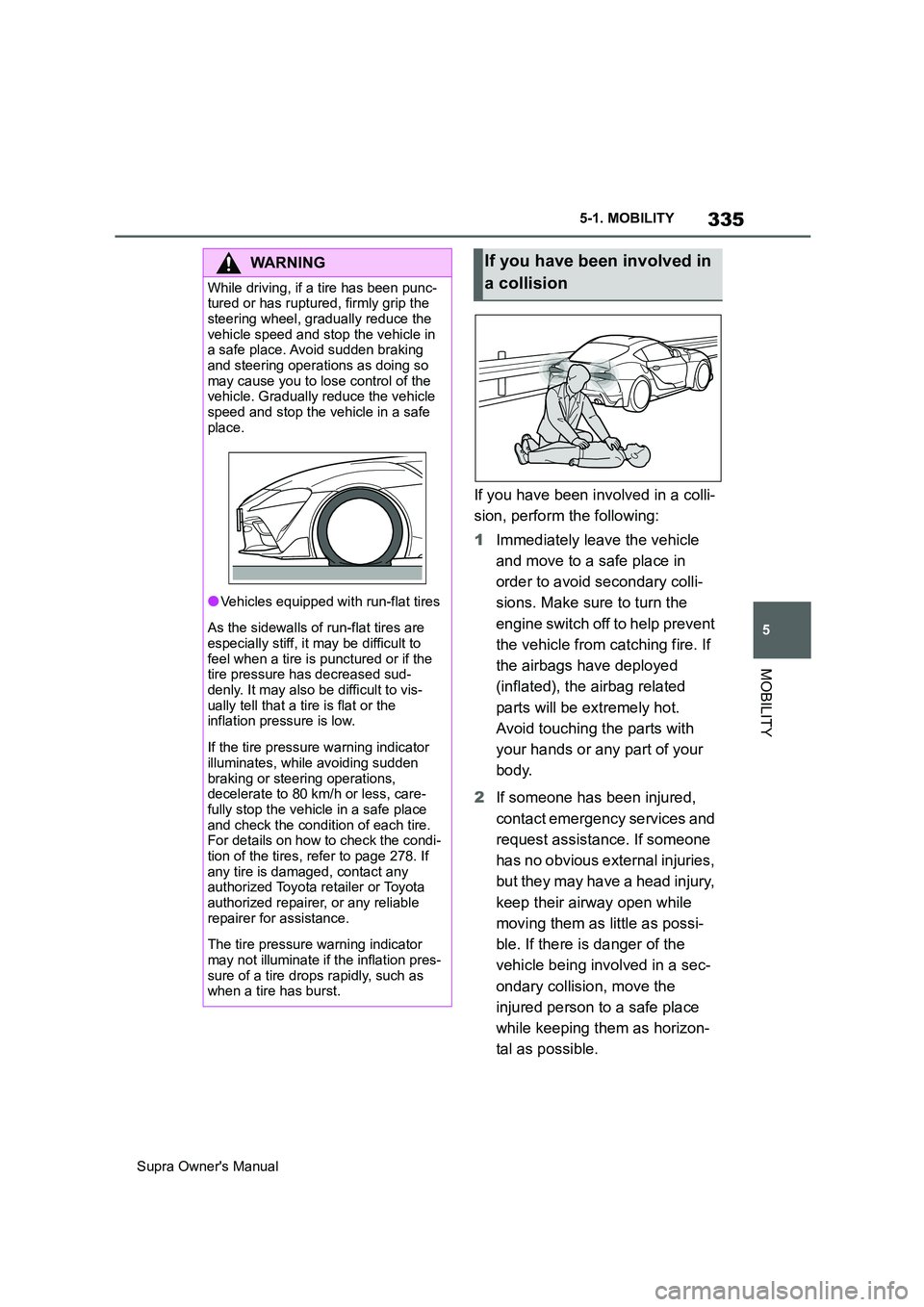2019 TOYOTA SUPRA tire pressure
[x] Cancel search: tire pressurePage 102 of 456

102
Supra Owner's Manual3-1. CONTROLS
Sit so your entire back is in contact with the seatback
Position the shoulder belt so that it does not contact your neck or slide
off your shoulderG
H
WARNING
Do not recline the seatback exces-
sively while driving.
If the seatback is reclined excessively,
the seat belt will be completely inef-
fectual as an occupant protection
device in the case of sudden braking
or a collision. Also, in the event of a
collision, the lap belt may slide past
the hips and apply restraint forces
directly to the abdomen, or your neck
may contact the shoulder belt,
increasing the risk of death or serious
injury.
WARNING
Make sure that all passengers wear
their seat belt correctly.
Use of seat belts may be mandatory
under local laws and regulations. If a
seat belt is not worn properly, an
occupant may contact interior parts or
be thrown from the vehicle in the case
of sudden braking or a collision, pos-
sibly resulting in death or serious
injury. Also, if an occupant has an
incorrect riding posture, the airbags
will be ineffectual as occupant protec-
tion devices and may actually cause
injuries when they deploy.
WARNING
Correct use of the seat belts when
pregnant:
Pregnant women must wear a seat
belt. Consult your physician for advice
on correct way to wear a seat belt.
Position the lap belt as low as possi-
ble over the hips and the shoulder
belt completely over the shoulder,
passing the center of the chest, so
that the seat belt does not apply any
pressure to the abdomen.
Page 279 of 456

279
5
Supra Owner's Manual5-1. MOBILITY
MOBILITY
for the respective load conditions
will apply, in accordance with the
vehicle's actual load condition.
Example: for a partially loaded
vehicle, the optimum tyre inflation
pressure is the one stated for a par-
tially loaded vehicle.
More information regarding wheels
and tyres can be obtained from any
authorized Toyota retailer or Toyota
authorized repairer, or any reliable
repairer.
The current tire pressure of each
installed wheel can be displayed on
the control display.
To ensure that they are displayed
correctly, the tyre sizes must be
stored in the system and must have
been set, see page 290, for the
mounted tyres.
The current tyre inflation pressure
value is shown on each tyre.Tyres heat up while driving. The
tyre inflation pressure increases
with the temperature of the tyre.
Tyres have a natural, uniform loss
of tyre inflation pressure.
Inflating devices can display a pres-
sure that may be up to 0.1 bar too
low.
The tyre inflation pressure inscrip-
tions on the tyre inflation pressure
sign on the door pillar only relate to
cold tyres or tyres at the same tem-
perature as the ambient tempera-
ture.
Only check the tyre inflation pres-
sures when the tyres are cold, i.e.:
• A driving distance of max. 2 km,
1.25 miles has not been
exceeded.
• If the vehicle has not moved
again for at least 2 hours after a
journey.
Regularly check the tyre inflation
pressure of the emergency wheel in
the boot and correct the pressure if
necessary.
1Determine the specified tyre
inflation pressures for the tyres For Australia/New Zealand
WARNING
The inflation pressures on the tyre
label are applicable only for tyres
explicitly mentioned on the label.
Inflation pressures for tyres that may
be covered by the label – by size,
speed category and load rating/load
index – but not explicitly mentioned
on the label may be different. Please
obtain adequate inflation pressures in
accordance with the tyre manufac-
turer's specifications from your tyre
dealer.
On the Control Display
Checking the tyre inflation
pressure
General
Checking using tyre inflation pres-
sure inscriptions on the door pillar
Page 290 of 456

290
Supra Owner's Manual5-1. MOBILITY
ble.
Tire chains cannot be mounted.
Snow tires should be used instead.
The system monitors the tyre infla-
tion pressure in the four fitted tyres.
The system warns if the tyre infla-
tion pressure in one or more tyres
has fallen.
Sensors in the tyre valves measure
the tyre inflation pressure and tyre
temperature.
The system detects the fitted tyres
automatically. The system shows
the preset specified pressures on
the Control Display and compares
them to the current tyre inflation
pressures.
If tyres are fitted which are not
listed on the tyre inflation pressure
labels in the vehicle, see page 278, for example tyres with special
approval, the system must be
actively reset. The current tyre
inflation pressures are then
accepted as the specified values.
To operate the system, also please
comply with the other information
and notes in the chapter Tyre infla-
tion pressure, see page 278.
The following requirements must be
met for the system, otherwise relia-
ble signalling of a loss of tyre infla-
tion pressure is not ensured:
• After each tyre or wheel change,
the system has detected the fit-
ted tyres, updated the relevant
information and, after a short
journey, shown it on the Control
Display.
If the system does not detect the tyres
Snow chains
Selecting tire chains
NOTICE
■Driving with tire chains
Do not fit tire chains. Tire chains may
damage the vehicle body and sus-
pension, and adversely affect driving
performance.
Tyre Pressure Monitor (TPM)
Principle
General
Safety note
WARNING
The display showing the specified
tyre inflation pressures does not
replace the tyre inflation pressure
information on the vehicle. If incorrect
data has been entered into the tyre
settings, the specified tyre inflation
pressures will also be incorrect. As a
result, reliable signalling of a loss of
tyre inflation pressure can no longer
be guaranteed. There is a danger of
injury and damage to property. Make
sure that the tyre sizes of the fitted
tyres are displayed correctly and that
they match the specifications on the
tyres and the tyre inflation pressure
information.
Operating requirements
Page 335 of 456

335
5
Supra Owner's Manual5-1. MOBILITY
MOBILITY
If you have been involved in a colli-
sion, perform the following:
1Immediately leave the vehicle
and move to a safe place in
order to avoid secondary colli-
sions. Make sure to turn the
engine switch off to help prevent
the vehicle from catching fire. If
the airbags have deployed
(inflated), the airbag related
parts will be extremely hot.
Avoid touching the parts with
your hands or any part of your
body.
2If someone has been injured,
contact emergency services and
request assistance. If someone
has no obvious external injuries,
but they may have a head injury,
keep their airway open while
moving them as little as possi-
ble. If there is danger of the
vehicle being involved in a sec-
ondary collision, move the
injured person to a safe place
while keeping them as horizon-
tal as possible.
WARNING
While driving, if a tire has been punc-
tured or has ruptured, firmly grip the
steering wheel, gradually reduce the
vehicle speed and stop the vehicle in
a safe place. Avoid sudden braking
and steering operations as doing so
may cause you to lose control of the
vehicle. Gradually reduce the vehicle
speed and stop the vehicle in a safe
place.
●Vehicles equipped with run-flat tires
As the sidewalls of run-flat tires are
especially stiff, it may be difficult to
feel when a tire is punctured or if the
tire pressure has decreased sud-
denly. It may also be difficult to vis-
ually tell that a tire is flat or the
inflation pressure is low.
If the tire pressure warning indicator
illuminates, while avoiding sudden
braking or steering operations,
decelerate to 80 km/h or less, care-
fully stop the vehicle in a safe place
and check the condition of each tire.
For details on how to check the condi-
tion of the tires, refer to page 278. If
any tire is damaged, contact any
authorized Toyota retailer or Toyota
authorized repairer, or any reliable
repairer for assistance.
The tire pressure warning indicator
may not illuminate if the inflation pres-
sure of a tire drops rapidly, such as
when a tire has burst.
If you have been involved in
a collision
Page 429 of 456

429
6
Supra Owner's Manual6-1. REFERENCE
REFERENCE
Tire Pressure Monitoring
System